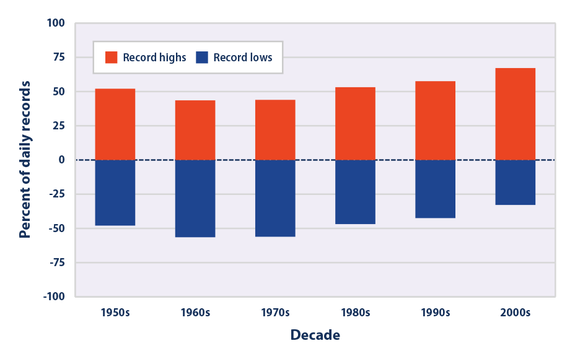It's damn cold, but heat records in the U.S. still dominate

Yes, records for cold temperatures are breaking as an off-balance polar vortex sloshes over a vast region of the U.S.
And while it sure feels frigid out there, overall, the number of daily cold records set in the U.S. has been consistently dwarfed by the number of warm or high temperature records. The score isn't even close. High records over the last decade are outpacing low records by a rate of two to one.
Earth has warmed by 1.8 degrees Fahrenheit (1 degree Celsius) since the late 1800s, and this boost in warming translates to significantly more heat records than cold records. But during winter — particularly when biting Arctic air sometimes washes over the U.S. — cold records will still be made.
"Even in a warming world, we can expect cold outbreaks and even record cold to occur," Zachary Labe, a climate scientist focused on the changing Arctic at the University of California at Irvine, said over email.
"However, in the long-term, temperatures are warming during the wintertime in the United States," said Labe.
"In fact, we are seeing an increase in daily heat records, and we are NOT seeing an increase in daily cold records," Michael Mann, a climate scientist at Penn State University, added via email.
"The trend is in exactly the direction we would expect as a result of a warming planet," Mann said.
Another coooold start.
Widespread temperatures of -15° to -30° to start today, and yes that is actual temperatures. While far less wind than yesterday, still enough for added danger & a wind chill warning is in effect until noon. Dress in layers and limit exposure. #ILwx #INwx pic.twitter.com/qMdECdUD30— NWS Chicago (@NWSChicago) January 31, 2019
These numbers are supported by federal data from the National Oceanic and Atmospheric Administration (NOAA) and Environmental Protection Agency (EPA). Just what do the numbers say?
In the past week, with the winter-time arrival of extremely frigid Arctic air, there have been 131 record low daily temperatures set in the U.S. (meaning the record for that particular day, not all-time) and 66 record highs, noted Matthew Kelsch, a scientist at the University Corporation for Atmospheric Research, in an interview.
When only the past week is considered, daily cold records are more dominant. But zooming out and looking at the longer-term trends — the trends that really matter — changes the story.
SEE ALSO: Antarctica’s once sleepy ice sheets have awoken. That's bad.
In January 2019, even with potent Arctic blasts, there have been 651 daily record highs in the U.S. versus 341 record lows, said Kelsch, citing updated weather statistics from NOAA.
And over the past 10 years, the numbers grow more stark. "Record highs are outpacing lows by about two to one," noted Kelsch.
There have been 21,461 record daily highs, and 11,466 lows.

Image: EPA
"This is twice the rate we would expect in the absence of global warming," noted Mann.
While there is a dramatic difference between overall high and low record temperatures, the most significant differences are felt after the sun sets. It's staying much warmer at night.
"In particular, there are fewer unusually cold low temperatures at night," said Labe. Instead, significantly more record high minimum temperatures have been set.
A total of 35,263 of these nighttime records were set over the last decade, noted Kelsch. This outpaces night low records by a staggering rate of three to one.
Warming trends, both during the day and night, are expected to continue.
Monthly atmospheric carbon dioxide (CO₂) concentrations - now updated through 2018
You can see the seasonal cycle and the obvious rise... pic.twitter.com/EAE0n32Rks— Zack Labe (@ZLabe) January 28, 2019
"State-of-the-art climate models continue to project an increase in the number of record high temperatures and decrease in the number of record lows," said Labe.
Arctic blasts have become increasingly common as the polar vortex becomes more susceptible to spilling south, but these frigid events simply can't compete with the long-term score, which is now controlled by an accelerated global warming trend.
"Weather is not climate — an individual event does not disprove a long term trend," noted Syracuse University climate scientist Tripti Bhattacharya via email.
WATCH: Ever wonder how the universe might end?


